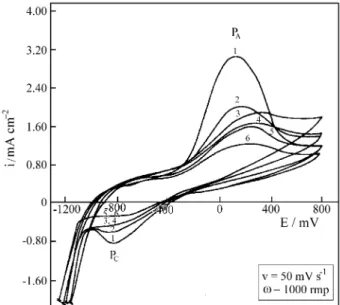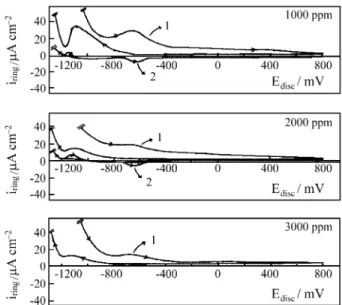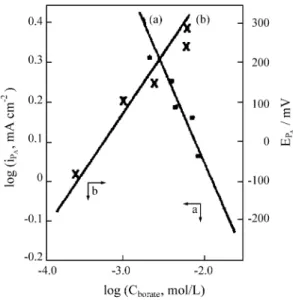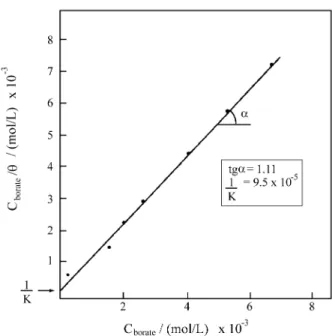Passivation of Iron in Solutions Containing Borate Using Rotating
Ring-Disc Measurements
Emilse M.A. Martini*
a, and Iduvirges L. Muller
ba
Instituto de Química, Universidade Federal do Rio Grande do Sul, Av. Bento Gonçalves 9500, 91501-970 Porto Alegre - RS, Brazil b
Departamento de Metalurgia, Universidade Federal do Rio Grande do Sul, Av. Osvaldo Aranha, 99 - s.607, Porto Alegre - RS, Brazil
Investigou-se o comportamento eletroquímico do ferro em soluções neutras de perclorato de sódio contendo pequenas concentrações de borato de sódio, através da técnica de voltametria cíclica e empregando-se eletrodo rotatório de disco e anel. Nas soluções de perclorato, a passivação do ferro ocorreu após o pico anódico correspondente à zona ativa, no qual foi observada a dissolução de espécies Fe2+ e Fe3+. Quando é adicionado borato à solução, tanto a densidade de corrente do pico anódico quanto a quantidade de espécies ativas de ferro solúveis diminuem. Para uma concentração constante de perclorato e borato, o aumento do pH do meio mostrou ser menos efetivo na promoção da passivação do ferro do que a presença de borato. Os resultados demonstraram que a interação entre o íon borato e a superfície eletródica ocorre por adsorção química, de acordo com a isoterma de Langmuir.
The electrochemical behavior of iron in neutral solutions of perchlorate and low borate concentrations was investigated using cyclic voltammetry and the rotating ring-disc electrode techniques. In solutions containing just perchlorate, iron passivation was observed at potentials higher than the potential of an anodic peak corresponding to the active range at which the dissolution of Fe2+ and Fe3+ species was detected. When borate is added to the solution, this anodic peak decreased as well as the amount of the active soluble species. The increase of pH, keeping the borate and perchlorate concentrations constant, was found to be less effective at promoting iron passivation than the increase of borate concentration. The results demonstrated that the interaction between borate ion and the electrode surface occurs by chemical adsorption according to the Langmuir isotherm.
Keywords: iron passivity, borate passivity, anodic films
Introduction
During the last 30 years, the buffer sodium borate-boric acid has been intensively used as an electrolyte in many electrochemical studies that investigate the behavior of several metals and alloys, mainly iron, nickel, copper, cobalt and steel1-10. The concentrations of each component of this buffer are always high e.g. 0.1 mol/L or higher, in order to promote a low ohmic drop in the solution. In these studies the borate buffer acts as support electrolyte or as a blank test to which the results of experiments using agres-sive anions, such as chloride and sulphate, could be com-pared. The borate buffer solution is often used in these
studies because in this electrolyte the cathodic reduction of initial oxide formed in air is easy11 and the anodic passiva-tion is very efficient11-18.
Nevertheless most authors have not investigated the influence of the borate anion on the studied metal dissolu-tion and passivadissolu-tion processes. Some authors have consid-ered this anion to be a corrosion inhibitor, mainly for iron and steel, and have explained its performance as a pH controller buffer11-18. Only a few authors have considered
the borate anion as an adsorption inhibitor12-15 and studies in which this anion is used in small concentrations are very scarce12-13. This kind of study should be carried out when an adsorption inhibitor is investigated. No data in the
ture was found concerning the active species dissolution in the presence of borate.
The use of a rotating disc electrode presents several advantages because there is an important feature that dist-inghishes it from the other reaction surfaces in a flowing fluid, that is, the thickness of the hydrodynamic boundary layer is constant along the whole disc surface. This fact assures that the mass transport to any point of the disc surface is identical. Such a reaction surface is uniformly accessible from the standpoint of diffusion19.
Therefore, in experiments using RRDE, any soluble species produced at the disc, that is electrochemically ac-tive, could be homogeneously collected by the Pt ring and therefore identified by this way.
The equations for convective diffusion, derived from the general equation of Navier-Stokes, are simplified when the reaction site is the surface of a rotating disc. Such simplifications make the use of RDE very convenient in electrochemical experiments.
Nevertheless, the equations derived for RDE could not be applied for very small or very large values for the electrode rotation rate (ω). When ω is smaller than 100 rpm, the hydrodynamic boundary layer becomes large and ap-proaches the disc radius. Under this condition, the derived equations are not followed. On the other hand, for values of ω larger than 10,000 rpm, the flow regime becomes turbulent. Values of the Reynolds number greater than 2 x 105 are not convenient for RDE experiments because this
represents the limit for laminar flux conditions. This fact is important because when the flux becomes turbulent the equations of mass transport are also no longer valid.
For these reasons the range of ω generally used in RDE studies is between 100 and 10,000 rpm21.
The aim of this study is to compare the electrochemical behavior of iron in a solution of sodium perchlorate 0.1 mol/L containing or not small amounts of borate in the absence of its acid pair, as in this manner the borate buff-ering capacity is decreased. At these conditions the use of rotating ring-disc electrode is used in order to control the dissolution of active species before and after of borate addition.
Experimental
The working electrode consisted of a Gallard-Schlesin-ger 99.999% pure iron disc embedded in PTFE, with an exposed area of 0.1886 cm2. This electrode was polished on SiC paper down to grade 1000 and 0.1 µm alumina paste, and then washed, rinsed with bidistilled water and ethanol and dried. A potential of -1600 mV in relation of a satured calomel electrode (SCE) was applied for 10 min in the same working solution for reduction of air-formed films. For the rotatory ring-disc electrode (RRDE) experiments, a
plati-num ring with an area of 0.0651 cm2 with a collection factor of 0.2621 has been used. All experiments have been run with the electrode rotating at 1000 rpm. The solutions used were 0.1 mol/L sodium perchlorate to which 0 to 3000 ppm borax had been added. Whenever necessary, the pH was adjusted by adding a solution of 0.1 mol/L NaOH. All chemicals where analytical grade. The equipment consisted of a Pine bipotentiostat Model AFRDE 5, a BBC Model SE 780 X-Y recorder and a Pine analytical rotor. The electrolytical cell consisted of a pyrex glass flask with four entrances. Poten-tial has been measured against a saturated calomel electrode (SCE) provided with a double sintered glass junction and a Luggin capilary. The potentials are referred to it throughout the text. The counterelectrode was a platinum wire. The experiments have been run at room temperature and under a N2 atmosphere.
Results and Discussion
Voltammetric experiments with RRDE in 0.1 mol/L sodium perchlorate with the pH adjusted to 9 were car-ried out. Figure 1.a shows the results of disc current id
for the two first cycles obtained at a scan rate of 50 mV s-1. The ring current detected along the potential scan of the disc under oxidizing (+600 mV) or reducing condi-tions (-800 mV) is also shown. The voltammogram in perchlorate solution is characterized by an extensive ac-tive region with one single current peak (PA), after which
the electrode passivates. Along both the active as well as the passive zones iron dissolution occurs as Fe2+ species as is shown by peaks 1, 2 and 3 on the ring curve (Fig. 1.b). Dissolution by formation of Fe3+ species is also observed during the oxidation of the disc electrode (Fig. 1.c). The total anodic charge evaluated by integrating the id curve
referring to the first cycle is 79.6 mC cm-2. The charge under the ir ring curves, kept in oxidizing conditions as well
of small intensity (PC). After one complete voltammetric
cycle the total cathodic charge is smaller than the anodic one, even taking into account the dissolutive processes. This fact shows that the film reduction occurs only partially or otherwise at potentials as negative as that of H2
evolu-tion. During the reduction process, Fe2+ species are caught on the ring (peak 4, Fig. 1.b). Probably part of the Fe(III) species of the film are reductively dissolved to Fe2+ species. With continuous potential cycling and also increasing scan rate, both the anodic as well as the cathodic peak increase and separate from each other. Thus the processes represented by peaks PA and PC correspond to a redox pair,
which becomes more irreversible with cycling or with increasing potential scan rate. The growing distance be-tween anodic and cathodic peaks may be related with the ageing processes of the film22, which dehydrates, getting less conductive and rendering its reduction and further reoxidation more difficult. The increase of the intensity of these peaks with the progressive cicling is a probable con-sequence of increasing the active area of the electrode, due to higher rugosity of the surface, resulting from the disso-lution processes.
Thus iron passivation in perchlorate solutions is not an efficient process because it requires the transport of a great amount of charge. Perchlorate anion is not expected to adsorve on the metallic surface and thus the film-forming mechanism does not occur by a topochemical pathway, but probably by precipitation, requiring the species saturation near the electrode, with high current transport.
Different amounts of borate, from 500 to 3000 ppm were added to the 0.1 mol/L sodium perchlorate solution and Fig. 2 shows the obtained voltammograms in the same
condition as those in Fig. 1. The anodic peak PA as well as
the cathodic peak PC diminish according to borate
concen-tration and their potentials are shifted to more positive values. In the inverse scan, the curves cross the absciss axis always at about the same potential (-400 mV), which may indicate that the same species is reduced under all condi-tions.
The influence of consecutive potential cycling on the voltammetric profiles has been verified for borate concen-trations from 1000 to 3000 ppm. Figure 3 presents the results obtained for the first five cycles in the perchlorate
Figure 1. a - Cyclic voltammograms of iron in 0.1 mol/L sodium perchlorate (pH). First and second cycles.
b - Ring current density (ERING = 600 mV) during disc potential scan,
showing four peaks (1, 2, 3 and 4).
c - Ring current density (ERING = - 800 mV) during disc potential scan.
Figure 2. Cyclic voltammograms of iron in 0.1 mol/L sodium perchlorate (pH 9) with the addition of borax: 1 - 500 ppm; 2 - 1000 ppm; 3 - 1500 ppm; 4 - 2000 ppm; 5 - 2500 ppm; 6 - 3000 ppm.
Figure 3. Cyclic voltammograms of iron in 0.1 mol/L sodium perchlorate + 2500 ppm borax (pH 9). PA and PC: anodic and cathodic peaks in the
solution containing 2500 ppm of borate. The results shown in Figs. 2 and 3 allow the demonstration of the inhibiting properties of borate ion. As its concentration increases, passivation becomes more efficient with a smaller anodic charge transport. The comparison between the first cycle and the following ones shows that the anodic peak PA is
substituted by three anodic shoulders, PI, PII and PIII (Fig.
3), with smaller current densities. The second cycle and the following ones are identical in shape to the first cycle obtained for iron in 0.1 mol/L borax solution (Fig. 4) under the same conditions, which are associated with passive film fomation. Thus, it seems to exist competitivity among the actions of the different anions: if borate cannot avoid me-tallic dissolution and the consequent film formation from species precipitation in perchlorate solution, at least it can make it more difficult, polarizing the process that occurs at PA. In the following cycles, the formed film is not totally
reduced, and suffers an ageing processes through dehydra-tion, which makes it more resistive. This film acts as a physical barrier regarding the dissolution of iron in the presence of perchlorate.
The experiments using RRDE, with the ring electrode either kept under oxidizing (+600 mV) or under reducing conditions (-800 mV) during the disc potential scan, al-lowed the verification of the influence of borate on the dissolution processes. Figure 5 shows the results obtained in solutions of 1000, 2000 and 3000 ppm of borate for the first cycle of the disc. In the forward scan, Fe2+ species result from the dissolution of the disc at -650 mV, that corresponds to the active region. The amount of Fe2+ spe-cies tends to decrease as borate concentration increases. Also Fe3+ species are formed at -630 mV. No corresponding current has been detected by the ring in the solution con-taining the highest concentration of borate (3000 ppm). In the reverse scan, the ring registers Fe2+ dissolution during the film reduction, at a more negative potential than in the
absence of borate. The ring electrode current also dimin-ishes as borate concentration increases, as in the direct scan. The results obtained with the ring-disc electrode permit the comparison of the metal dissolution processes in the absence as well as in presence of borate. This anion seems to prevent the dissolution of iron as Fe2+ and Fe3+ species
at potentials higher than -400 mV, exactly when there is a greater dissolution in the medium containing only per-chlorate. Thus borate stabilizes a film formed at more negative potentials, corresponding to the active zone, and also helps the film in preventing the dissolution process at higher potentials (Fig. 1.b, peak 3).
The charge, evaluated by integrating the ring current along the oxidation process, permits the calculation of the fraction of the total charge transferred at the disc referring to the dissolution processes. Thus, in the solution contain-ing 1000 ppm borate, this fraction corresponds to 1.7% and diminishes to only 1.1% in solutions containing 2000 or 3000 ppm. This fact shows that the borate inhibiting action on the dissolution processes does not increase remarkably with higher concentrations.
The influence of pH on the electrochemical behavior of iron in perchlorate+borate solutions has also been verified. The borate concentration was fixed at 1000 ppm, potential scan rate was kept at 50 mV s-1. pH values from 9 to 12
have been tested by adding NaOH to the solutions. As the pH increases, the current referring to peaks PA and PC
decreases. The anodic peak potential is shifted to more positive values and the cathodic peak to more negative values. The increase of pH causes a polarization of the processes represented by peaks PA and PC, increasing thus
the redox process irreversibility. The anodic and cathodic
Figure 4. Cyclic voltammogram of iron in 0.1 mol/L borax solution (pH 9). PI, PII and PIII: anodic shoulders. PC: cathodic current region.
Figure 5. Platinum ring current density variation with disc potential scan in 0.1 mol/L sodium perchlorate with borax addition (pH 9). 1 - ERING =
current densities also decrease as pH increases. The pres-ence of oxydriles improves borate inhibiting action.
Figure 6 presents the effects of borate concentration and pH on the density of the anodic current peak (iPA) and of
the corresponding peak potential (EPA). The variation of log
i with log CBORATE is also shown, where i is the anodic
current density at -100 mV in the Tafel region of the anodic peak PA (Fig. 3). The straigt line obtained has a linear
correlaction coefficient of 0.96 and an inclination of -0.31, which corresponds to the reaction order of the oxidation process with respect to the borate anion. The negative value indicates the inhibiting character of this anion. From current densities evaluated at the same potential (-100 mV) but for different pH with fixed borate (1000 ppm) and perchlorate
(0.1 mol/L) concentrations, a value of -0.20 was found for the reaction order in relation to the pH, showing that this factor also contributes to the inhibition of the metal oxida-tion, but in a less remarkable way.
The surface fraction covered with borate species has been evaluated for iron in perchlorate solutions containing different amounts of borate and data were fitted to a Lang-muir isotherm. This isotherm is defined by the expression:
Cborate
θ =
1
Kadsor ption+Cbor ate (1)
where CBORATE is the borate anion concentration in mol/L;
Kadsorption is the equilibrium constant of the adsorption /
desorption process and θ is the fraction of the electrode surface covered by the adsorbed species. This θ can be determined by:
θ=(io− ii) io
(2)
where io is the anodic current density in absence of borate
a n d ii is the anodic current density in different
concentrations of this anion, evaluated at a constant potential (-200 mV) before the anodic peak PA. From Figs.
1 and 2, io and ii for different borate concentrations have
been determined and the values for θ as a function of CBORATE were calculated. Figure 7 represents CBORATE / θ
Figure 6.3. a. Variation of anodic current density (at E = - 100 mV) with borax concentration.
b. Variation of anodic current density (at E = - 100 mV) with pH. Figure 6.1. a. Variation of anodic peak current density with borax
concentration.
b. Effect of borax concentration on the anodic peak potential.
against CBORATE. A linear behaviour is found as is foreseen
by the Langmuir isotherm with a linear correlation coefficient of 0.9999. The straight line slope value (1.11) is near to the theoretical value (1.0). The linear coefficient (1/Kadsorption) permits the evaluation of Kadsorption, resulting
in a value of 1.05 x 104. The free energy variation for the adsorption process defined as ∆G0 = -RTln Kadsorption,
resulted in -5.5 kcal/mol for the experimental conditions of this paper. This value indicates that the interaction between borate ion and the electrodic surface occurs by chemical adsorption.
Conclusions
The electrochemical behaviour of iron in the slightly alkaline solutions investigated depends on the anion pre-sent in solution. In the presence of perchlorate, one anodic peak (PA) and one cathodic peak (PC) are observed. In the
presence of only borate, three anodic shoulders (PI, PII and
PIII) and one cathodic current region are observed with
smaller current densities than in the perchlorate medium. These anodic shoulders in the medium containing only borate may be related to film formation reactions with different kinetic controls. Small amounts of borate added to perchlorate solution change the voltammetric profile. The anodic peak PA as well as the cathodic peak PC diminish
and their potentials are shifted to more positive values. Thus there is a meaningful decrease of the total anodic charge for passivation of iron and an increase of the passivation effi-ciency in this medium. During the potentiodynamic experi-ments, when the electrode potential is cycled, the remaining film which had not been totally reduced in the previous
scan, makes the passivation even more efficient, probably as it offers nucleation sites for the continuous growth of the oxide film. The RRDE experiments showed that borate anions, even in small quantities, inhibit iron dissolution. This property is due not only to its buffering capacity, that maintains the alkaline pH close to the electrode, but also to its chemical adsorption on the metallic surface, according to a Langmuir isotherm, stimulating the formation of a better film of passive oxide that obstructs dissolution.
References
1. Jovancicevic, V.; Kainthla, R.C.; Tang, Z.; Yang, B.; Bockris, J.O’M. Langmuir 1987, 3, 388.
2. Kozlowski, W.; Flis J., Corros. Sci. 1988, 28, 787. 3. Acosta, C.A.; Salvarezza, R.C.; Videla, H.A.; Arvia,
A.J. Corros Sci. 1985, 25, 291.
4. Vela, E.M.; Vilche, J.R.; Arvia, A.J. J. of Appl.
Elec-trochem. 1986, 16, 490.
5. Szklarska-Smialowska, Z.; Kozlowski, W. J.
Electro-chem. Soc. 1984, 131, 234.
6. Szklarska-Smialowska, Z.; Kozlowski, W. J.
Electro-chem. Soc. 1984, 131, 499.
7. Kozlowski, W.; Szklarska-Smialowska, Z. J.
Electro-chem. Soc. 1984, 131, 723.
8. Kozlowski, W.; Flis, J. Corros. Sci. 1991, 32, 861. 9. Rubim,J. J. Electrochem. Soc. 1993, 140, 1601. 10. Rubim, J.; Dunnwald, J. J. Electroanal. Chem. 1989,
258, 327.
11. Bhardwaj, R.C.; González-Martin, A.; Bockris, J.O’M. J. Electrochem. Soc. 1991, 138, 1901. 12. Bardwell, J.A.; MacDougall, B. J. Electrochem. Soc.
1988, 135, 2157.
13. MacDougall, B.; Bardwell, J.A. J. Electrochem. Soc.
1988, 135, 2437.
14. Hurlen, T.; Gunvaldsen, S.; Blaker, F. Electrochim.
Acta 1984, 29, 1163.
15. Fischer, M.; Gruner, W.; Reinhardt, G. Corros. Sci.
1975, 15, 275.
16. Ogura, K. J. Electroanal. Chem. 1977, 79, 149. 17. Goetz, R., Mitchell, D.F.; MacDougall, B.; Graham,
M.J. J. Electrochem. Soc. 1987, 134, 535.
18. Martini, E.M.A.; Amaral, S.T.; Muller, I.L. J. Braz.
Chem. Soc. 1995, 6, 77.
19. Levich,V.G. Physichemical Hydrodynamics, p. 60, Prentice Hall, New Jersey, 1962.
20. Bard, A.J.; Faulkner, L.R. Electrochemical Methods, p. 280, John Wiley & Sons, New York, 1980. 21. Albery, J.; Hitchmann, M.L. Ring Disc Electrode, p.
95, Clarendon Press, Oxford, 1971.
22. D‘Alkaine, C.V.; Souza, L.M.M. de; Nart, F.C.
Cor-ros. Sci. 1993, 34, 129.
23. Albani, O.A.; Zerbino, J.O.; Vilche, J.R.; Arvia, A.J.
Electrochim. Acta 1986, 31, 1406.
24. Juanto,S.; Zerbino, J.O.; Miguez, M.I.; Vilche, J.R.; Arvia, A.J. Electrochim. Acta 1987, 32, 1743. 25. Albani, O.A.; Gassa, L.M.; Zerbino, J.O.; Vilche, J.R.;
Arvia, A.J. Electrochim. Acta 1990, 35, 1437. 26. Castro, E.B.; Vilche, J.R.; Arvia, A.J. Corros. Sci.
1991, 32, 37.
27. Schrebler-Guzman, R.S.; Vilche, J.R.; Arvia, A.J. J.
Appl. Electrochem. 1981, 11, 551.
28. Juanto, S.; Schrebler, R.S.; Zerbino, J.O.; Vilche, J.R.; Arvia, A.J. Electrochim. Acta 1991, 36, 1143. 29. Seo, M.; Sato, N. Corros. Sci. 1978, 18, 577. 30. Seo, M.; Sato, N.; Lumsden, J.B.; Staehle, R.W.
Cor-ros. Sci. 1977, 17, 205.
31. Amaral, S.T.; Muller, I.L. Corros. Sci. 1999, 41, 759. 32. Amaral, S.T.; Muller, I.L. Corros. Sci. 1999, 41, 747. 33. Amaral, S.T.; Muller, I.L. Corrosion 1999, 55, 17. 34. Génin, J.M.R. et al. Corros. Sci. 1996, 38, 1751.



